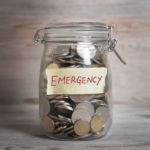An emergency savings account is a primary element of a financial plan. Having money set aside and always available for the unexpected expenses eliminates a lot of financial stress and the need to rely on credit cards or other forms of short-term debt.
How Much Do You Need?
An emergency savings account is a source of money to draw on during unexpected circumstances. It is basically an insurance fund for sudden setbacks. This might include a job loss, having to stop work due to major health issues, major car or home repairs, a natural disaster, an unforeseen tax bill, a death in the family, or emergency travel expenses.
The alternative of income replacement insurance is expensive, and you are not always guaranteed a payout. If you don’t make any claims on your insurance, you don’t receive any money back, but if you consistently save for emergencies, you will eventually have more than you need and be earning money on your savings.
Most experts recommend saving three to six months of your current living expenses, but these are some scenarios where you might want to save more:
- Those with children who are still dependent on you.
- If you have a mortgage.
- If layoffs are common in your industry
- If you are retired and don’t have other sources of income.
- If you are self-employed or your income is unstable.
- Single parents without a second source of income.
If you spend less than you earn, have no dependents, and no debt you can keep fewer months of living expenses in emergency savings.
A portion of the emergency savings should be easily accessible, in accounts that won’t be penalized for withdrawals.
You need to be able to cover rent or mortgage, utilities, insurance (car, home, life), routine maintenance (car and home), groceries, child-care, and other debt payments. Find the total monthly cost of these items and multiply that by three to calculate a three-month saving goal; multiply by six to determine what is needed to cover six months. This total is for basic survival—discretionary items are not included (the things that are nice, but you can survive without them). This is money needed to survive if the unexpected hits.
How to Start
Open an account that you absolutely will not touch unless a true emergency arises. Aim to save $1,000 as quickly as possible. Set up automatic payments so you will not spend the money. Deposit gifts, pay raises, bonuses, or tax refunds when possible. Go through your bank and credit card statements to see where you can cut expenses and divert that money toward an emergency savings account until you establish a three-to-six-month cushion. When you need to withdraw money, aim to replenish it.
Lessons from Ants
Go to the ant, O sluggard; consider her ways, and be wise. Without having any chief, officer, or ruler, she prepares her bread in summer and gathers her food in harvest. Proverbs 6:6–8
Not only are ants extremely busy creatures, but they are also known for their ability to store food that is ultimately shared with others in their colony. Most of us have seen an ant carrying off a large breadcrumb under the picnic table. They are not feasting on the bread; they are harvesting it for use in the future. This is the wisdom that God wants us to learn from.
What about debt repayment?
If you have debt, repaying that debt as fast as you can is a priority. You will be in a much stronger financial position once you are debt free. Make a commitment to take on no new debt.
If you don’t have much room in your spending plan for savings, saving $5 or $10 a week is still a good starting point for your emergency savings account.
Set a goal; then challenge yourself with spending fasts, like a no-eating-out month, a no-entertainment-expense month, etc. Find friends to do this with you; some competition may help you build your savings account faster!
How many savings accounts do you need?
Once you hit your goal for your emergency savings account, consider opening another bank account for future needs. This might include replacing a vehicle, necessary maintenance on your home, investing in more insulation for your home, installing solar panels, buying a home, holidays, and more.
Summary
At least three savings accounts plus your KiwiSaver are useful:
- Short-term expenses that don’t occur every month. That includes annual holidays, dentist and vehicle servicing
- Long-term savings for buying a house, home improvements, car replacement and major holidays
- Emergency savings for unexpected events
The article next month addresses how to maintain these savings accounts.
Other articles that may be helpful are:
Why having an emergency savings account is essential
Six money myths you need to stop believing.

